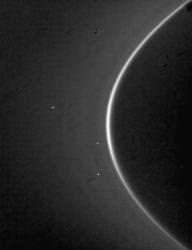When you look at Saturn, it’s easy to see the distinct rings, with dark bands in between them. For some of the rings, scientists think they know their sources: several of the planet’s moons are feeding particles into the rings. The planet’s mysterious G ring has had them puzzled since Cassini first arrived at Saturn in 2004. But now this ring is giving up its secrets.
The particles in Saturn’s G ring are confined to their position through gravitational interaction with Saturn’s moon Mimas. Micrometeoroids collide with the particles, and release even smaller, dust-sized particles. The plasma field generated by Saturn’s magnetic field sweeps through the cloud of particles, and pulls out the finest ones, creating the G ring.
This discovery will be published in the August 2nd issue of the journal Science, and was based on Cassini spacecraft observations in 2004 and 2005. The photos gathered by Cassini have been turned into movies, showcasing an entire orbital revolution. The G ring is revealed as a bright arc on the ring’s inner edge. To see the animation, click here.
Several of Saturn’s other rings are associated with a specific moon. For example, Enceladus’ geysers are supplying material for the E ring. And other moons sculpt and shape the rings, such as the effect that Prometheus and Pandora have on the F ring. But this isn’t the case for the G ring.
The latest Cassini images show that the ring stretches around Saturn like a bright arc 150 km wide, reaching about 1/6th around the planet. It contains about as much mass as a single ice rich moon 100 metres wide. It was seen several times during Cassini’s 2004 arrival at Saturn, but scientists hadn’t worked out where it came from until now.
Original Source:Cassini-Huygens News Release

